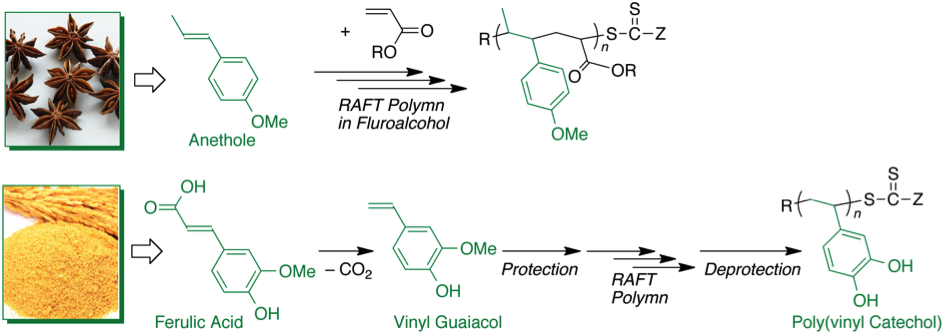Development of Precision Polymerization and
Precision Polymer Synthesis
Synthetic polymers are molecules with high molecular weights and are prepared by linking small molecules together via covalent bonds, i.e., polymerization. Because of significant developments in the petrochemical industry, a variety of polymers have been synthesized and have made great contributions to our modern life. Meanwhile, natural macromolecules such as proteins and nucleotides are essential for biological activity. The structures of most of these natural macromolecules are precisely controlled in terms of molecular weight, stereo structure, and monomer sequence, which dictate their shapes and functions. Similarly, precise control of the structures of synthetic polymers is expected to contribute to the development of polymer materials. Indeed, many high performance or functional polymer materials have been developed to date via structural control, but the degree of control in these synthetic polymers is still far behind compared to that in natural macromolecules. Thus, the precision synthesis of polymers is one of the hottest research areas in polymer chemistry.
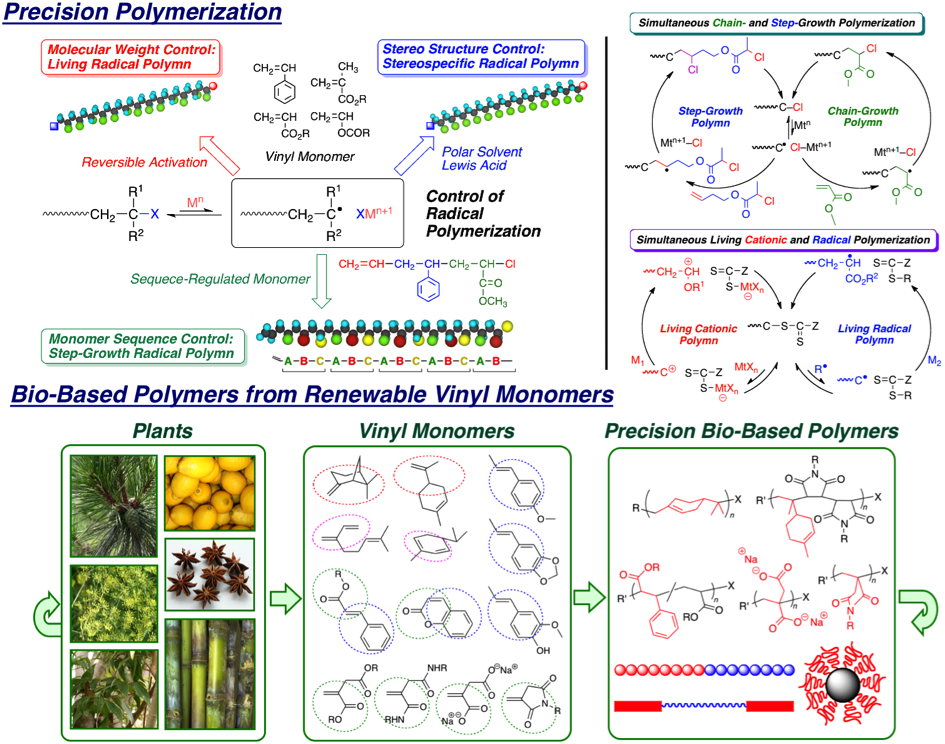
In our laboratory, we focus on developing novel precision polymerization and precision polymer synthesis, which will lead to new functional polymer materials.
Below are several research topics that are currently being investigated by our group.
- Molecular Weight Control
-
Living Polymerization via Reversible Activation of
Covalent BondsLiving polymerization is defined as chain-growth polymerization that consists of only initiation and propagation, i.e., without any termination and chain-transfer reactions. This enables precision control of the molecular weights and terminal groups of the resulting polymers. Living polymerization was first discovered for the anionic polymerization of non-polar conjugated vinyl monomers such as styrene and butadiene, a polymerization involving the formation of stable propagating anionic species. Since then, numerous living polymerizations, including the living cationic polymerization of electron-rich vinyl monomers and the living or controlled radical polymerization of various vinyl monomers, have been attained via similar methods based on the reversible activation of covalent species.
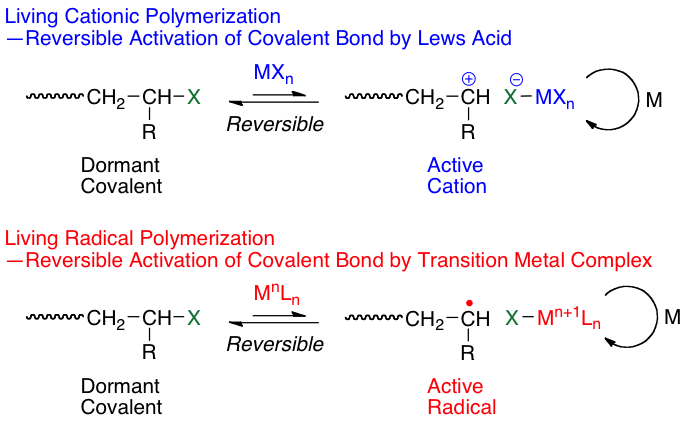
Our group has been working on the development of living polymerization by proposing and realizing new methods for the reversible activation of covalent species in the radical and cationic polymerization of vinyl monomers.
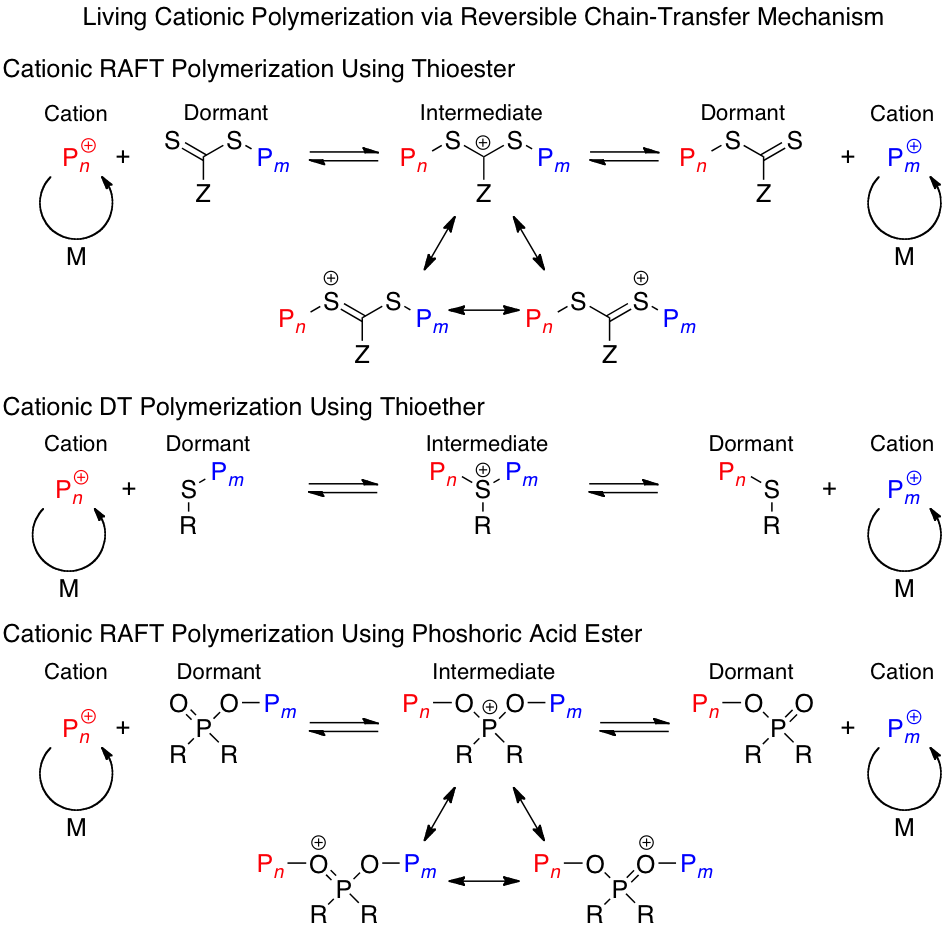
- Stereo-Structure Control
-
Stereospecific Living Polymerization
The properties of vinyl polymers depend on their stereo structure. Thus, stereospecific polymerization will lead to improvements in polymer properties. In coordination polymerization, in which coordination sites can control the direction of the insertion of monomers into polymer chains, stereoregular polyolefins have been synthesized and industrialized. By contrast, in radical and cationic polymerization, a high degree of regulation of stereo-structures has been difficult because of the lack of sufficient stereochemical control. Another challenge associated with stereo regulation in vinyl polymers is stereospecific living polymerization, which can simultaneously control the molecular weight and stereo structure of the resulting polymers.
Our group has been working on stereospecific living polymerization by introducing stereo-control mechanisms into living radical and cationic polymerizations.
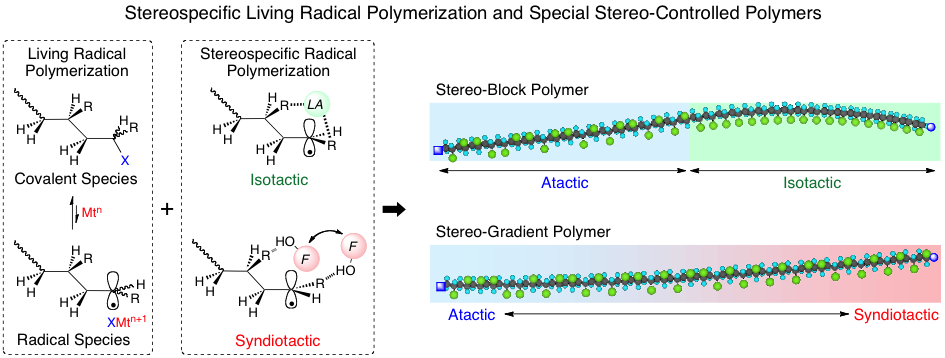
- Monomer Sequence Control
-
Monomer sequence control is one of the ultimate goals in polymer synthesis because control over monomer sequence is expected to determine the conformation of polymer chains and to improve their properties and functions. Many approaches for monomer sequence control in various polymerizations have been proposed and examined.
Our group has been addressing this subject in the case of vinyl polymers by developing our own original approaches for monomer sequence control in the polymerization of vinyl monomers.
Monomer Sequence Control in Chain-Growth Radical
CopolymerizationIn radical polymerization, various vinyl monomers can be copolymerized because of the high reactivity of the propagating radical species. Radical copolymerization has been widely employed in industry because it enables the synthesis of a variety of copolymers with different properties depending on the comonomers and their composition. In most radical copolymerizations, the monomer reactivity ratio determines the monomer sequence statistically, thus providing statistical copolymers.
In our group, we have been investigating the control of monomer sequence in radical copolymerization using a compound that selectively interacts with one component to change the monomer reactivity ratio. Furthermore, we have been combining this method with living polymerization to synthesize copolymers with controlled monomer sequences and molecular weights.
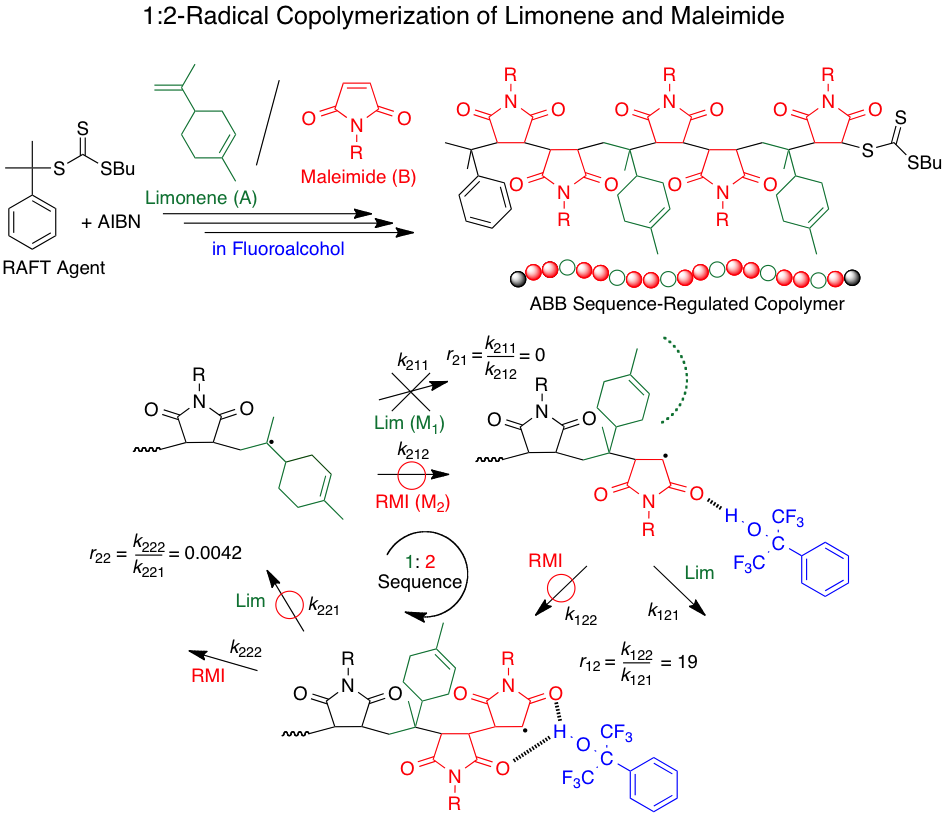
Monomer Sequence Control by Step-Growth Radical
PolymerizationIt is generally difficult to control monomer sequences perfectly in chain-growth radical copolymerization, as the monomer sequences are statistically determined by the monomer reactivity ratios, resulting in polymers with statistical sequence distributions.
In our group, we have succeeded in synthesizing perfectly sequence-regulated vinyl polymers by developing a metal-catalyzed step-growth radical polymerization of sequence-regulated oligomers, which are prepared by iterative single monomer atom transfer radical addition reactions of vinyl monomers. We are further evolving this method by combining other controlled polymerizations with these iterative single monomer addition reactions.
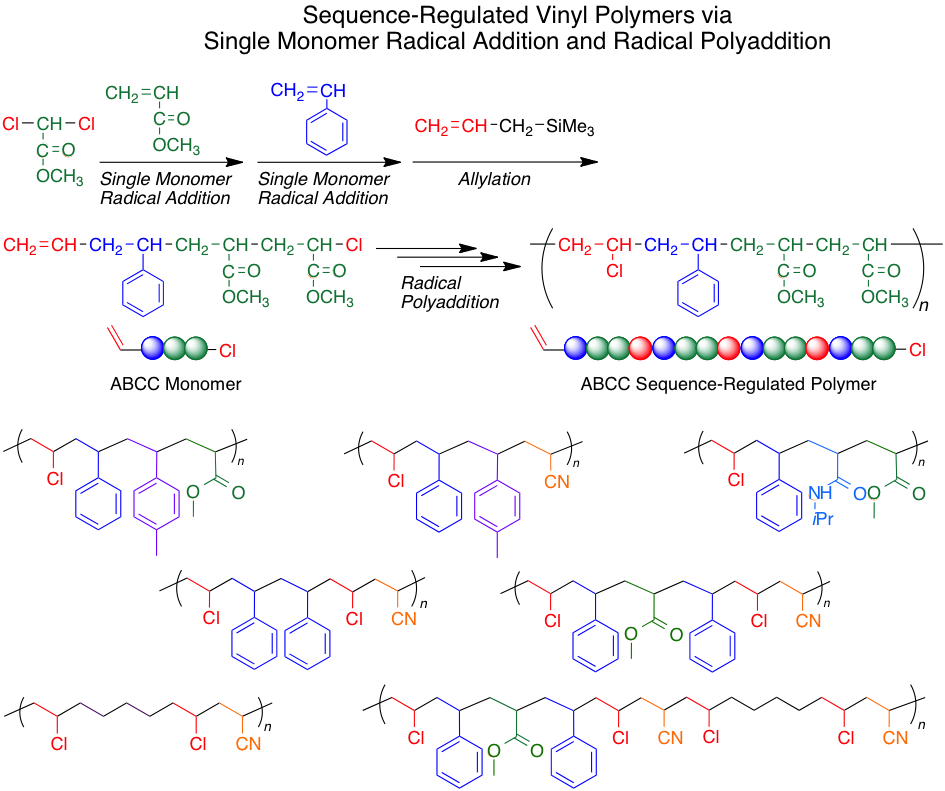
- Combination of Different Polymerizations for
Novel Polymer Design -
It is generally difficult to control monomer sequences perfectly in chain-growth radical copolymerization, as the monomer sequences are statistically determined by the monomer reactivity ratios, resulting in polymers with statistical sequence distributions.
Our group has been working on utilizing our knowledge of precision polymerization to develop a new polymer synthesis based on combinations of different polymerizations.
Simultaneous Chain- and Step-Growth Radical
PolymerizationThe abovementioned step-growth radical polymerization proceeds via the same key step as metal-catalyzed chain-growth living radical polymerization, i.e., the metal-catalyzed activation of carbon–halogen bonds to afford radical species. We have thus simultaneously conducted these two polymerizations, i.e., metal-catalyzed chain- and step-growth radical polymerizations, and succeeded in the synthesis of polymers consisting of vinyl polymer and polyester units in a single polymer chain. We are applying this method for the synthesis of multiblock copolymers and special structural polymers.
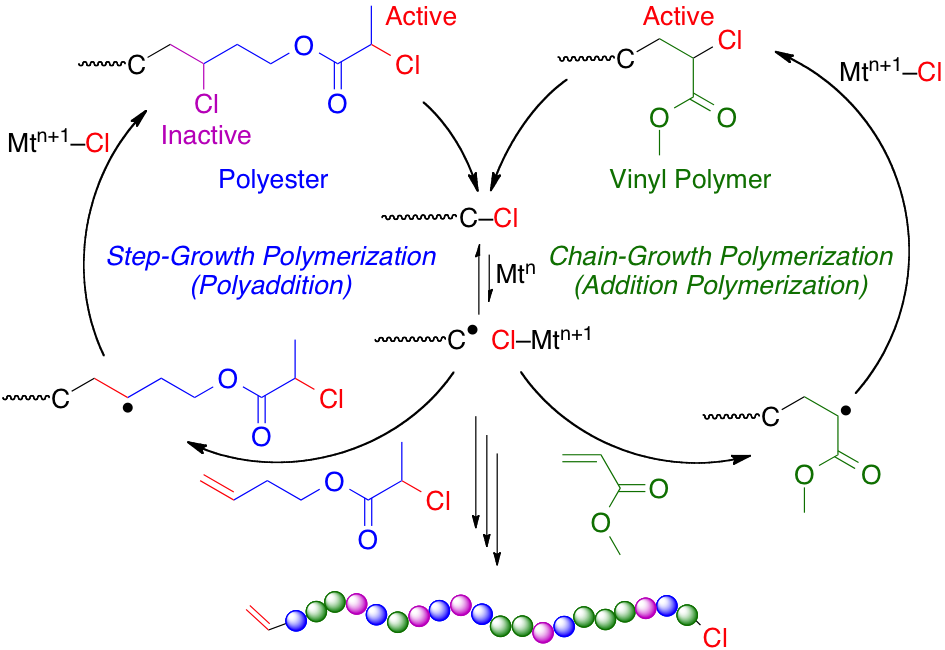
Simultaneous Living Radical and Cationic Polymerization
Both living cationic and radical polymerizations are based on common strategies, i.e., the reversible activation of covalent species into the propagating species. Our group has realized interconvertible living cationic and radical polymerizations via concurrent and reversible activation of the common dormant species into radical and cationic species and succeeded in the synthesis of copolymers with novel monomer sequences that cannot be attained from a single propagating species. We are further expanding this method to new polymer synthesis.
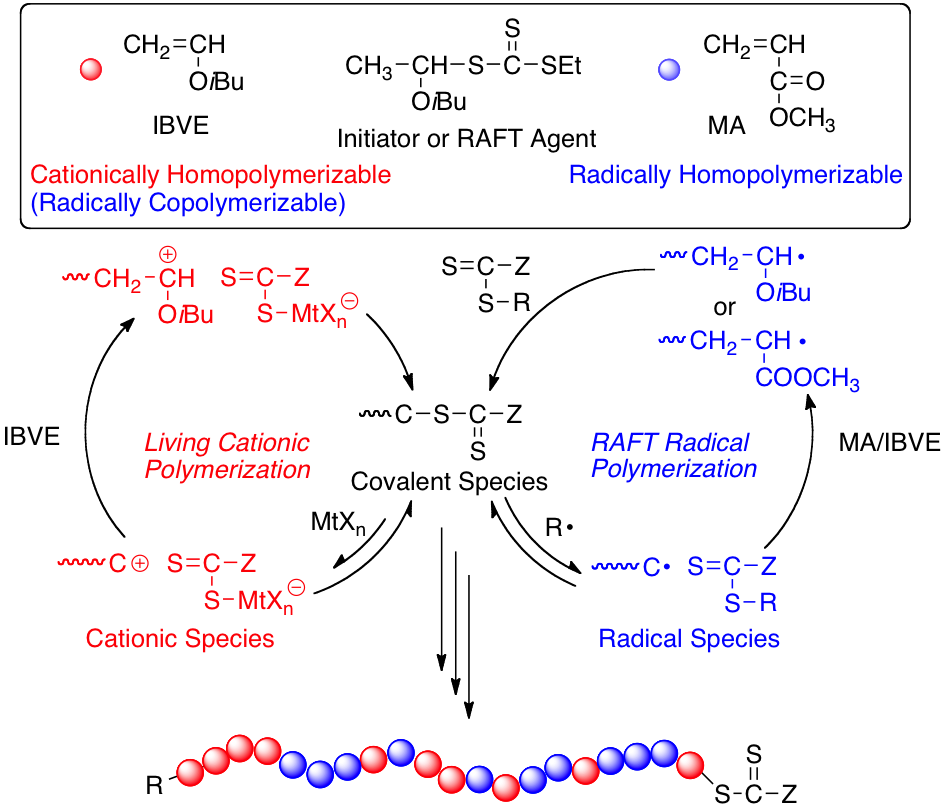
- Precision Synthesis of Polymers with
Special Architectures -
Block, Star, Graft, and Special Structural Polymers
Living polymerization enables the precision synthesis of polymers with various architectures, including block, star, and graft polymers. These polymers have unique properties originating from their special structures and indeed have been produced, commercialized, and used in many applications.
In our group, we have been synthesizing various special structural polymers using living radical, living cationic, and our own developed polymerizations. In addition, we are targeting functional polymer materials by examining the structures and properties of polymers through collaborative research.
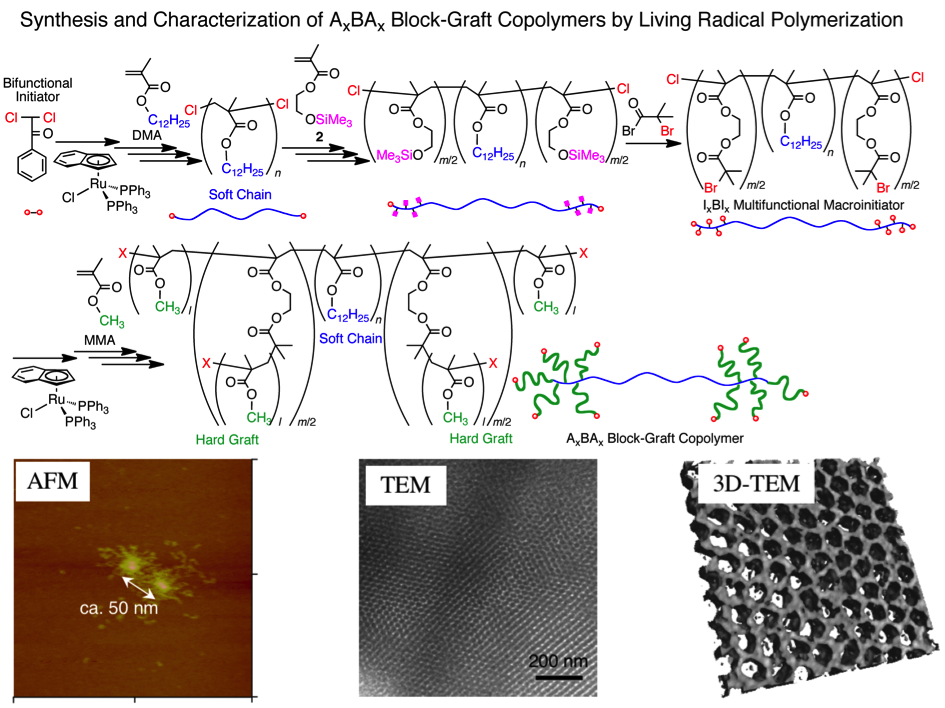
- Novel Bio-Based Polymers from
Renewable Vinyl Monomers -
In view of environmental issues such as global warming and petroleum resource depletion, renewable resources are becoming important for sustainable development in industry and society. In polymer science and industry, bio-based polymers originating from plant-derived compounds have been attracting considerable attention and have even been commercialized.
Our group has been focusing on naturally abundant plant-derived vinyl compounds and developing novel bio-based vinyl polymers by utilizing our knowledge on and experiences with precision polymerization of petroleum-derived vinyl monomers. We categorize these plant-derived vinyl monomers, which include terpenes, phenylpropanoids, and other compounds derived via the fermentation of carbohydrates, into several families, such as olefins, styrenes, and acrylics, based on their structures around the vinyl groups. This enables us to develop suitable precision polymerization systems for these families and to design high performance or functional bio-based polymers based on their inherent natural structures.
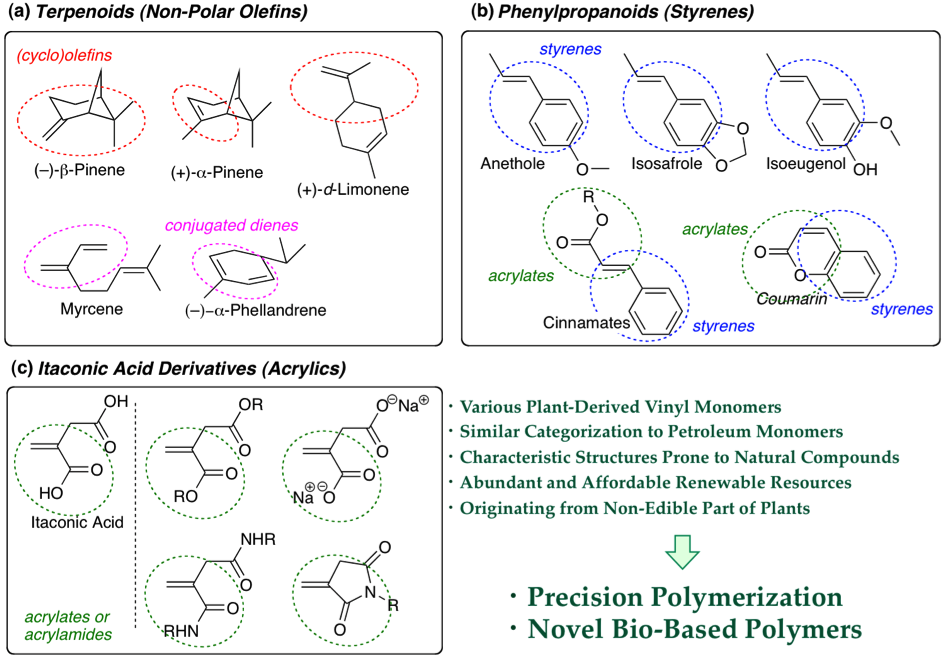
Precision Polymerization of Terpenoid Monomers
There are a variety of hydrocarbon vinyl compounds, such as pinene and limonene, in the terpenoid family. These compounds can be regarded as olefinic vinyl monomers. We have succeeded in the synthesis of bio-based cycloolefin polymers with high transparency and heat resistance and low hygroscopicity by using appropriate polymerization systems. We are further developing novel bio-based vinyl polymers from various terpenes via living cationic and radical polymerizations and copolymerizations.

Precision Polymerization of Phenylpropanoid Monomers
Phenylpropanoids, a class of plant-derived compounds that consist of phenyl and C3 (propyl derivative) groups, in which there are various vinyl compounds, such as β-methylstyrenes and cinnamic acid derivatives. These compounds can be regarded as styrene and/or acrylic derivatives and generate radical, cationic, or anionic species stabilized by the conjugated groups. Although their reactivity is low because of the steric hindrance around the vinyl groups, they can be copolymerized via radical copolymerization or can be transformed into more reactive vinyl monomers that can be polymerized into novel bio-based polystyrene derivatives.
